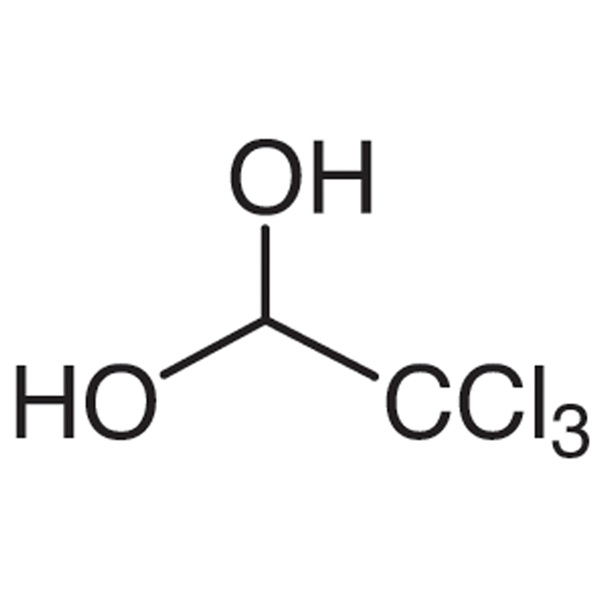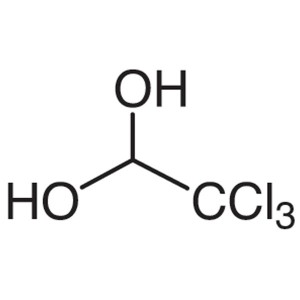Chloral Hydrate CAS 302-17-0 Assay ≥99.5% (Titration) High Purity
Shanghai Ruifu Chemical Co., Ltd. is the leading manufacturer of Chloral Hydrate (CAS: 302-17-0) with high quality. Ruifu Chemical has been supplying Chloral Hydrate more than 15 years.
Ruifu Chemical can provide worldwide delivery, competitive price, excellent service.
Purchase Chloral Hydrate, please contact us by e-mail: alvin@ruifuchem.com
| Chemical Name | Chloral Hydrate |
| Synonyms | Trichloroacetaldehyde Hydrate; 2,2,2-Trichloroethane-1,1-Diol; |
| Stock Status | In Stock, Commercial Production |
| CAS Number | 302-17-0 |
| Molecular Formula | C2H3Cl3O2 |
| Molecular Weight | 165.39 g/mol |
| Melting Point | 57℃(lit.) |
| Boiling Point | 97℃ |
| Density | 1.43g/ml at 20℃ |
| Sensitive | Light Sensitive |
| Solubility | Very Soluble in Water, Freely Soluble in Ethanol (96 percent) |
| Storage Temperature | Store Long-Term at 2-8℃ |
| COA & MSDS | Available |
| Origin of Product | Shanghai, China |
| Product Categories |
Pharmaceutical Intermediates |
| Brand | Ruifu Chemical |
| Items | Specifications | Results |
| Appearance | White to Off-White Needle Crystalline Solid | Conforms |
| Assay / Analysis Method | ≥99.5% (Titration) | 99.61% |
| Appearance of the Solution | Clear and Colourless | Complies |
| Melting Point | 51.0-54.0℃ | 52.0-54.0℃ |
| pH (10 %, 20℃) | 3.5-5.5 | 4.6 |
| Chloride (Cl) | ≤100ppm | <100ppm |
| Loss on Drying | ≤0.50% | 0.4% |
| Residue on Ignition | ≤0.10% | <0.01% |
| Heavy Metals (Pb) | ≤20ppm | <10ppm |
| Arsenic (AS2O3) | <1ppm | <1ppm |
| Chloral-Alcoholate | Complies to EP10 Standard | Complies |
| Non-Volatile Residue | ≤0.10% | Complies |
| Infrared Spectrum | Conforms to Structure | Conforms |
| Conclusion | The product has been tested and complies with the given specifications | |
Package: Bottle, Aluminium foil bag, 25kg/cardboard drum, or according to customer's requirement.
Storage Condition: May be air or light sensitive. Keep the container tightly closed. Store in a cool, dry (2-8℃) and well-ventilated warehouse away from incompatible substances. Keep away from sunshine; avoid fire, moisture.
Shipping: Deliver to worldwide by air, by FedEx / DHL Express. Provide fast and reliable delivery.
Chlorali Hydras
C2H3Cl3O2 Mr 165.4
[302-17-0]
DEFINITION
2,2,2-Trichloroethane-1,1-diol.
Content: 98.5 per cent to 101.0 per cent.
CHARACTERS
Appearance: colourless, transparent crystals.
Solubility: very soluble in water, freely soluble in ethanol (96 per cent).
IDENTIFICATION
A. To 10 mL of solution S (see Tests) add 2 mL of dilute sodium hydroxide solution R. The mixture becomes cloudy and, when heated, gives off an odour of chloroform.
B. To 1 mL of solution S add 2 mL of sodium sulfide solution R. A yellow colour develops which quickly becomes reddish-brown. On standing for a short time, a red precipitate may be formed.
TESTS
Solution S. Dissolve 3.0 g in carbon dioxide-free water R and dilute to 30 mL with the same solvent.
Appearance of solution. Solution S is clear (2.2.1) and colourless (2.2.2, Method II).
pH (2.2.3): 3.5 to 5.5 for solution S.
Chloral alcoholate. Warm 1.0 g with 10 mL of dilute sodium hydroxide solution R, filter the supernatant solution and add 0.05 M iodine dropwise until a yellow colour is obtained. Allow to stand for 1 h. No precipitate is formed.
Chlorides (2.4.4): maximum 100 ppm.
Dilute 5 mL of solution S to 15 mL with water R.
Heavy metals (2.4.8): maximum 20 ppm.
10 mL of solution S diluted to 20 mL with water R complies with test A. Prepare the reference solution using lead standard solution (1 ppm Pb) R.
Non-volatile residue: maximum 0.1 per cent.
Evaporate 2.000 g on a water-bath. The residue weighs a maximum of 2 mg.
ASSAY
Dissolve 4.000 g in 10 mL of water R and add 40.0 mL of 1 M sodium hydroxide. Allow to stand for exactly 2 min and titrate with 0.5 M sulfuric acid, using 0.1 mL of phenolphthalein solution R as indicator. Titrate the neutralised solution with 0.1 M silver nitrate, using 0.2 mL of potassium chromate solution R as indicator. Calculate the number of millilitres of 1 M sodium hydroxide used by deducting from the volume of 1 M sodium hydroxide, added at the beginning of the titration, the volume of 0.5 M sulfuric acid used in the 1st titration and two-fifteenths of the volume of 0.1 M silver nitrate used in the 2nd titration. 1 mL of 1 M sodium hydroxide is equivalent to 0.1654 g of C2H3Cl3O2.
STORAGE
In an airtight container.
How to Purchase? Please contact Dr. Alvin Huang: sales@ruifuchem.com or alvin@ruifuchem.com
15 Years Experience? We have more than 15 years of experience in the manufacture and export of a wide range of high quality pharmaceutical intermediates or fine chemicals.
Main Markets? Sell to domestic market, North America, Europe, India, Korea, Japanese, Australia, etc.
Advantages? Superior quality, affordable price, professional services and technical support, fast delivery.
Quality Assurance? Strict quality control system. Professional equipment for analysis include NMR, LC-MS, GC, HPLC, ICP-MS, UV, IR, OR, K.F, ROI, LOD, MP, Clarity, Solubility, Microbial limit test, etc.
Samples? Most products provide free samples for quality evaluation, shipping cost should be paid by customers.
Factory Audit? Factory audit welcome. Please make an appointment in advance.
MOQ? No MOQ. Small order is acceptable.
Delivery Time? If within stock, three days delivery guaranteed.
Transportation? By Express (FedEx, DHL), by Air, by Sea.
Documents? After sales service: COA, MOA, ROS, MSDS, etc. can be provided.
Custom Synthesis? Can provide custom synthesis services to best fit your research needs.
Payment Terms? Proforma invoice will be sent first after confirmation of order, enclosed our bank information. Payment by T/T (Telex Transfer), PayPal, Western Union, etc.
Risk Codes
R25 - Toxic if swallowed
R36/38 - Irritating to eyes and skin.
R39/23/24/25 -
R23/24/25 - Toxic by inhalation, in contact with skin and if swallowed.
R11 - Highly Flammable
R36/37/38 - Irritating to eyes, respiratory system and skin.
R36 - Irritating to the eyes
R20/21/22 - Harmful by inhalation, in contact with skin and if swallowed.
Safety Description
S26 - In case of contact with eyes, rinse immediately with plenty of water and seek medical advice.
S45 - In case of accident or if you feel unwell, seek medical advice immediately (show the label whenever possible.)
S25 - Avoid contact with eyes.
S23 - Do not breathe vapour.
S36/37 - Wear suitable protective clothing and gloves.
S16 - Keep away from sources of ignition.
S27 - Take off immediately all contaminated clothing.
UN IDs UN 3286 3/PG 2
WGK Germany 2
RTECS FM8750000
HS Code 2911000000
Hazard Class 6.1(b)
Packing Group III
Chloral Hydrate (CAS: 302-17-0), was first used as a sedative and hypnotic in Germany in the 1870s. Chloral Hydrate is used in the short-term treatment of insomnia (to help you fall asleep and stay asleep for a proper rest) and to relieve anxiety and induce sleep before surgery. It is also used after surgery for pain and to treat alcohol.
Chloral Hydrate is a hypnotic and anticonvulsant. Hypnotic dose can induce sleep within 30 minutes, the hypnotic effect is mild, does not shorten REMS sleep, no obvious aftereffects. The hypnotic mechanism may be similar to that of barbiturates, causing approximate physiological sleep without obvious after-effect. Larger doses have anticonvulsant effects and can be used for convulsions caused by high fever, tetanus and epilepsy in children. Large doses can cause coma and anesthesia. Inhibit the respiratory and vasomotor centers of the medulla oblongata, leading to death.


